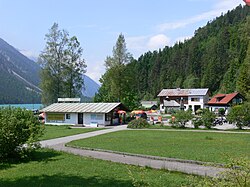Breitenwang | |
|---|---|
 | |
| Coordinates: 47°29′20″N10°43′40″E / 47.48889°N 10.72778°E | |
| Country | Austria |
| State | Tyrol |
| District | Reutte |
| Government | |
| • Mayor | Hans-Peter Wagner |
| Area | |
• Total | 18.94 km2 (7.31 sq mi) |
| Elevation | 850 m (2,790 ft) |
| Population (2018-01-01) [2] | |
• Total | 1,423 |
| • Density | 75.13/km2 (194.6/sq mi) |
| Time zone | UTC+1 (CET) |
| • Summer (DST) | UTC+2 (CEST) |
| Postal code | 6600 |
| Area code | 05672 |
| Vehicle registration | RE |
| Website | www.breitenwang. tirol.gv.at |
Breitenwang is a municipality and village in the district of Reutte in the Austrian state of Tyrol.


